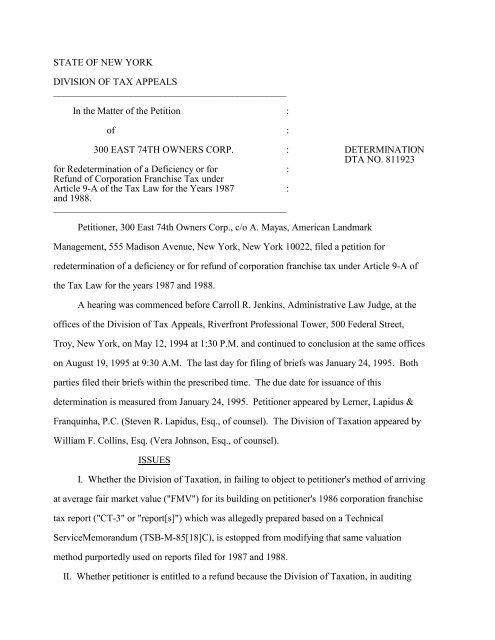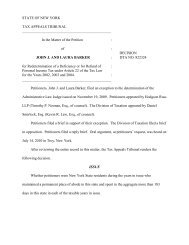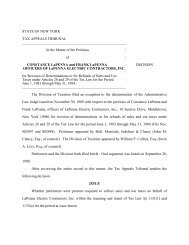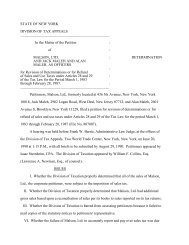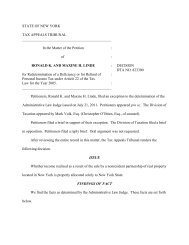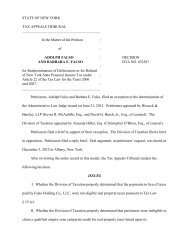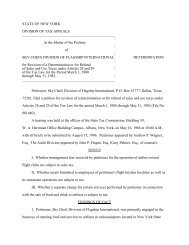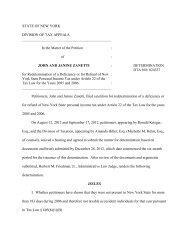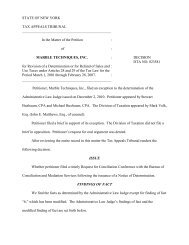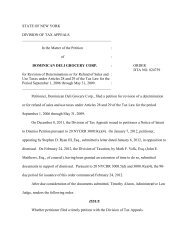STATE OF NEW YORK DIVISION OF TAX APPEALS In the Matter of ...
STATE OF NEW YORK DIVISION OF TAX APPEALS In the Matter of ...
STATE OF NEW YORK DIVISION OF TAX APPEALS In the Matter of ...
You also want an ePaper? Increase the reach of your titles
YUMPU automatically turns print PDFs into web optimized ePapers that Google loves.
<strong>STATE</strong> <strong>OF</strong> <strong>NEW</strong> <strong>YORK</strong><br />
<strong>DIVISION</strong> <strong>OF</strong> <strong>TAX</strong> <strong>APPEALS</strong><br />
________________________________________________<br />
<strong>In</strong> <strong>the</strong> <strong>Matter</strong> <strong>of</strong> <strong>the</strong> Petition :<br />
<strong>of</strong> :<br />
300 EAST 74TH OWNERS CORP. : DETERMINATION<br />
DTA NO. 811923<br />
for Redetermination <strong>of</strong> a Deficiency or for :<br />
Refund <strong>of</strong> Corporation Franchise Tax under<br />
Article 9-A <strong>of</strong> <strong>the</strong> Tax Law for <strong>the</strong> Years 1987 :<br />
and 1988.<br />
________________________________________________<br />
Petitioner, 300 East 74th Owners Corp., c/o A. Mayas, American Landmark<br />
Management, 555 Madison Avenue, New York, New York 10022, filed a petition for<br />
redetermination <strong>of</strong> a deficiency or for refund <strong>of</strong> corporation franchise tax under Article 9-A <strong>of</strong><br />
<strong>the</strong> Tax Law for <strong>the</strong> years 1987 and 1988.<br />
A hearing was commenced before Carroll R. Jenkins, Administrative Law Judge, at <strong>the</strong><br />
<strong>of</strong>fices <strong>of</strong> <strong>the</strong> Division <strong>of</strong> Tax Appeals, Riverfront Pr<strong>of</strong>essional Tower, 500 Federal Street,<br />
Troy, New York, on May 12, 1994 at 1:30 P.M. and continued to conclusion at <strong>the</strong> same <strong>of</strong>fices<br />
on August 19, 1995 at 9:30 A.M. The last day for filing <strong>of</strong> briefs was January 24, 1995. Both<br />
parties filed <strong>the</strong>ir briefs within <strong>the</strong> prescribed time. The due date for issuance <strong>of</strong> this<br />
determination is measured from January 24, 1995. Petitioner appeared by Lerner, Lapidus &<br />
Franquinha, P.C. (Steven R. Lapidus, Esq., <strong>of</strong> counsel). The Division <strong>of</strong> Taxation appeared by<br />
William F. Collins, Esq. (Vera Johnson, Esq., <strong>of</strong> counsel).<br />
ISSUES<br />
I. Whe<strong>the</strong>r <strong>the</strong> Division <strong>of</strong> Taxation, in failing to object to petitioner's method <strong>of</strong> arriving<br />
at average fair market value ("FMV") for its building on petitioner's 1986 corporation franchise<br />
tax report ("CT-3" or "report[s]") which was allegedly prepared based on a Technical<br />
ServiceMemorandum (TSB-M-85[18]C), is estopped from modifying that same valuation<br />
method purportedly used on reports filed for 1987 and 1988.<br />
II. Whe<strong>the</strong>r petitioner is entitled to a refund because <strong>the</strong> Division <strong>of</strong> Taxation, in auditing
-2-<br />
petitioner's corporation franchise tax reports for 1987 and 1988, improperly arrived at <strong>the</strong><br />
average fair market value <strong>of</strong> petitioner's cooperative apartment building. 1<br />
FINDINGS <strong>OF</strong> FACT<br />
Petitioner, 300 East 74th Owners Corp., is a New York cooperative housing corporation<br />
and owns a cooperative apartment building at 300 East 74th Street ("<strong>the</strong> building" or "<strong>the</strong><br />
subject premises") in New York City. This cooperative was created pursuant to an <strong>of</strong>fering plan<br />
providing for 98,637 shares allocated to 233 apartment units. The <strong>of</strong>fering plan set forth <strong>the</strong><br />
following price to be paid to <strong>the</strong> sponsor:<br />
Total Cash:<br />
Additional Cash--Maximum<br />
<strong>In</strong>itial Price:<br />
Mortgage <strong>In</strong>debtedness<br />
Total Purchase Price:<br />
Less: Working Capital Retained by<br />
Apartment corporation<br />
Net Purchase Price <strong>of</strong> Property to<br />
Apartment Corporation:<br />
$ 98,637.00<br />
19,628,763.00<br />
6,298,067.00<br />
$26,025,467.00<br />
50,000.00<br />
$25,975,467.00<br />
Petitioner claims that it computed <strong>the</strong> fair market value ("FMV") <strong>of</strong> its building on its<br />
1986 New York corporation franchise tax report in accordance with a Technical Services<br />
Memorandum issued by <strong>the</strong> Division <strong>of</strong> Taxation ("Division") (TSB-M-85[18]C) ("<strong>the</strong> TSB<br />
Memorandum").<br />
The TSB Memorandum provides, in pertinent part:<br />
"Valuation <strong>of</strong> Cooperative Housing<br />
"Section 210.1(a)(2) <strong>of</strong> Article 9-A <strong>of</strong> <strong>the</strong> Tax Law provides for a tax on total<br />
business and investment capital <strong>of</strong> a taxpayer or <strong>the</strong> portion <strong>the</strong>re<strong>of</strong> allocated to<br />
New York. For a cooperative apartment house as defined in section 216 <strong>of</strong> <strong>the</strong><br />
<strong>In</strong>ternal Revenue Code, <strong>the</strong> statute provides for a tax on capital at a rate <strong>of</strong> fourtenths<br />
<strong>of</strong> a mill (.0004).<br />
"The statute requires <strong>the</strong> use <strong>of</strong> fair market value in <strong>the</strong> valuation <strong>of</strong> assets for <strong>the</strong><br />
tax on capital. Fair market value is defined in Section 3-4.5 <strong>of</strong> <strong>the</strong> regulations as<br />
<strong>the</strong> price at which a willing seller, not compelled to sell, will sell and a willing<br />
1 At <strong>the</strong> beginning <strong>of</strong> <strong>the</strong> hearing in this matter, <strong>the</strong> Division <strong>of</strong> Taxation moved to amend its<br />
answer to include a defense <strong>of</strong> lack <strong>of</strong> timeliness <strong>of</strong> <strong>the</strong> petition. That motion was subsequently<br />
withdrawn (tr., p. 133).
-3-<br />
purchaser, not compelled to buy, will buy. An appropriate indicator <strong>of</strong> <strong>the</strong> average<br />
fair market value <strong>of</strong> cooperative housing is <strong>the</strong> assessed value for real property tax<br />
purposes adjusted for <strong>the</strong> equalization rate.<br />
"Where only <strong>the</strong> assessed value <strong>of</strong> <strong>the</strong> cooperative is known, average fair market<br />
value may be computed by dividing <strong>the</strong> assessed value for real property tax<br />
purposes by <strong>the</strong> equalization rate . . . [emphasis added].<br />
"The cooperative is allowed to depreciate its costs. Thus, <strong>the</strong> values shown on <strong>the</strong><br />
federal balance sheet are such costs less accumulated depreciation. Since this will<br />
be a constantly declining value, book value as shown on <strong>the</strong> federal balance sheet<br />
will not be allowed as an alternative determination <strong>of</strong> average fair market value<br />
[emphasis in original].<br />
"Once a method <strong>of</strong> determining average fair market value is adopted by <strong>the</strong><br />
taxpayer on any report and is accepted by <strong>the</strong> Tax Commission, <strong>the</strong> method may<br />
not be changed on any subsequent report without <strong>the</strong> prior consent <strong>of</strong> <strong>the</strong> Tax<br />
Commission."<br />
Petitioner's computation <strong>of</strong> average FMV on its 1986 corporation franchise tax report<br />
was as follows (Division's Exhibit "L"):<br />
Total Assets <br />
from Federal Return:<br />
Less: Book value <strong>of</strong> property:<br />
Balance:<br />
Plus: Actual Assessed Value<br />
1985/86--$8,115,000 equalized<br />
at 68.29% $11,883,145.00<br />
1986/87--$8,635.000 equalized<br />
at 56.83%<br />
Market Value:<br />
Computed Average<br />
Fair Market Value: $14,020,879.00<br />
12/31/85 12/31/86<br />
$22,740,207.00 $22,217,591.00<br />
($22,296,011.00) ($21,697,614.00)<br />
$ 444,196.00 $ 519,977.00<br />
$15,194,440.00<br />
$12,327,341.00 $15,714,417.00<br />
Petitioner opines that <strong>the</strong> computation <strong>of</strong> average fair market value on its 1987 and 1988<br />
reports was arrived at in <strong>the</strong> same manner as is set forth above for 1986 (Division's Exhibits<br />
"H", "I" and "L" ). Petitioner's New York allocation percentage for <strong>the</strong> subject years is 100<br />
percent.<br />
tax due:<br />
Petitioner's CT-3 filed for 1987 shows <strong>the</strong> following computation <strong>of</strong> its capital base and<br />
Average Total Assets from Federal Return: $22,040,287.00<br />
Less: Real Property and securities<br />
included in previous line: ($21,398,415.00)<br />
Balance: $ 641,872.00
-4-<br />
Plus: Real Property at FMV: $16,873,215.00<br />
Adjusted Total Assets: $17,515,087.00<br />
tax due:<br />
Less: Total Liabilities: $ 6,157,665.00<br />
Total Capital Base: $11,357,422.00<br />
Tax @ .0004 $ 4,543.00<br />
Petitioner's CT-3 filed for 1988 shows <strong>the</strong> following computation <strong>of</strong> its capital base and<br />
Average Total Assets from Federal Return: $22,097,529.00<br />
Less: Real Property and securities<br />
included in previous line: ($20,800,018.00)<br />
Balance: $ 1,297,511.00<br />
Plus: Real Property at FMV: $17,122,000.00<br />
Adjusted Total Assets: $18,419,511.00<br />
Less: Total Liabilities: $ 6,771,232.00<br />
Total Capital: $11,648,279.00<br />
Tax @ .0004 $ 4,659.00<br />
Petitioner's CT-3's for 1987 and 1988 did not show how it arrived at a FMV <strong>of</strong><br />
$16,873,215.00 and $17,122,000.00, respectively, for its real property. There is no explanation<br />
for <strong>the</strong> difference in stated value on <strong>the</strong> CT-3's and petitioner's Federal corporation income tax<br />
returns (Form 1120).<br />
Sometime in 1991, <strong>the</strong> Division conducted an audit <strong>of</strong> petitioner's corporation franchise<br />
tax reports for 1987 and 1988. 2<br />
A letter was written to petitioner asking for additional<br />
information showing <strong>the</strong> value <strong>of</strong> <strong>the</strong> subject property, including a copy <strong>of</strong> <strong>the</strong> insurance policy<br />
on <strong>the</strong> property. <strong>In</strong> response, <strong>the</strong> auditor was provided with an insurance schedule summarizing<br />
<strong>the</strong> coverages. A copy <strong>of</strong> <strong>the</strong> policy was not provided. The insurance schedule reflected that<br />
<strong>the</strong> subject real property was insured for $23,760,000.00. No o<strong>the</strong>r evidence <strong>of</strong> fair market<br />
value was provided by petitioner. The Division issued a Statement <strong>of</strong> Audit Adjustment dated<br />
May 29, 1991 recomputing petitioner's taxable capital base and tax due for 1987 as follows:<br />
Total Assets from Federal Return: $22,040,287.00<br />
Less: Real Property included in<br />
previous line: $21,398,415.00<br />
2 At <strong>the</strong> time <strong>of</strong> <strong>the</strong> audit <strong>the</strong> statute <strong>of</strong> limitations had run for 1986, so no assessments were<br />
issued for that year (tr., pp. 188-189).
-5-<br />
Balance:<br />
Plus: land and building at<br />
insured value:<br />
Adjusted Total Assets:<br />
Less: Total Liabilities:<br />
Total Capital Base:<br />
Tax @ .004<br />
Tax per report<br />
Deficiency<br />
$ 641,872.00<br />
$27,820,730.00<br />
$28,462,602.00<br />
$ 6,157,665.00<br />
$22,304,937.00<br />
$8,992.00<br />
4,543.00<br />
4,379.00<br />
The Division also issued a Statement <strong>of</strong> Audit Adjustment dated May 29, 1991<br />
computing petitioner's tax for 1988 as follows:<br />
Total Assets from Federal Return: $22,097,529.00<br />
Less: Real Property included in<br />
previous line: $20,800,018.00<br />
Balance: $ 1,297,511.00<br />
Plus: land and building at<br />
insured value: $27,820,730.00
-6-<br />
Adjusted Total Assets: $29,118,241.00<br />
Less: Total Liabilities: $ 6,771,232.00<br />
Total Capital: $22,347,009.00<br />
Tax @ .004 8,939.00<br />
Tax per report 4,659.00<br />
Deficiency 4,280.00<br />
Both statements <strong>of</strong> audit adjustment stated as follows:<br />
"<strong>In</strong> determining tax on <strong>the</strong> capital base, one <strong>of</strong> <strong>the</strong> four methods <strong>of</strong><br />
computing tax as stated in New York State Tax Law, §210(1), it is required to<br />
include real property and marketable securities at fair market value.<br />
"Fair market value is defined in New York State Tax Regulations, §3-4.5 as<br />
<strong>the</strong> price at which a willing seller, not compelled to sell, will sell, and a willing<br />
purchaser, not compelled to buy, will buy.<br />
"Real property [sic] was adjusted to <strong>the</strong> insured value, since this amount<br />
more closely reflects fair market value."<br />
The Metropolitan Transportation Business Tax Surcharge ("MTA Surcharge") during<br />
<strong>the</strong> relevant period was 17 percent <strong>of</strong> a taxpayer's New York franchise tax. The issuance <strong>of</strong><br />
franchise tax deficiencies to petitioner resulted in issuance <strong>of</strong> a corresponding MTA Surcharge<br />
for <strong>the</strong> same years. A Statement <strong>of</strong> Audit Adjustment was issued to petitioner computing <strong>the</strong><br />
1987 MTA Surcharge as follows:<br />
N.Y.S. Franchise Tax: $8,922.00<br />
MTA Surcharge @ 17%: 1,517.00<br />
MTA Surcharge Reported: 772.00<br />
Deficiency: $ 745.00<br />
A Statement <strong>of</strong> Audit Adjustment was also issued to petitioner computing <strong>the</strong> 1988<br />
MTA Surcharge as follows:<br />
N.Y.S. Franchise Tax: $8,939.00<br />
MTA Surcharge @ 17%: 1,520.00<br />
MTA Surcharge Reported:<br />
Deficiency:<br />
792.00<br />
$ 728.00<br />
The Division issued a Notice <strong>of</strong> Deficiency dated May 29, 1991 asserting additional<br />
corporation franchise tax due for <strong>the</strong> year 1987 in <strong>the</strong> amount <strong>of</strong> $4,379.00, plus interest. On<br />
<strong>the</strong> same date a Notice <strong>of</strong> Deficiency was issued to petitioner asserting additional MTA<br />
Surcharge for 1987 in <strong>the</strong> amount <strong>of</strong> $745.00, plus interest.<br />
On May 29, 1991, <strong>the</strong> Division issued a Notice <strong>of</strong> Deficiency to petitioner asserting
-7-<br />
additional corporation franchise tax for 1988 in <strong>the</strong> amount <strong>of</strong> $4,280.00, plus interest. On <strong>the</strong><br />
same date, <strong>the</strong> Division issued to petitioner a Notice <strong>of</strong> Deficiency asserting additional MTA<br />
Surcharge for 1988 in <strong>the</strong> amount <strong>of</strong> $728.00, plus interest.<br />
Petitioner filed a request for conciliation conference with <strong>the</strong> Division's Bureau <strong>of</strong><br />
Conciliation and Mediation Services ("BCMS") challenging <strong>the</strong> above notices.<br />
On February 26, 1993, a Conciliation Order (CMS No. 117496) was issued to petitioner<br />
sustaining <strong>the</strong> notices. Petitioner <strong>the</strong>reupon filed a petition dated May 24, 1993 with <strong>the</strong><br />
Division <strong>of</strong> Tax Appeals and <strong>the</strong> instant proceeding ensued.<br />
Kathy Goodsell, Tax Technician II in <strong>the</strong> Division's corporation tax section, testified for<br />
<strong>the</strong> Division. She had reviewed <strong>the</strong> Division's audit records and was thoroughly familiar with<br />
<strong>the</strong>ir contents. Ms. Goodsell stated that <strong>the</strong> audit was conducted by Jim Bishop who is no<br />
longer with <strong>the</strong> Division. Ms. Goodsell represented <strong>the</strong> Division at <strong>the</strong> BCMS conference.<br />
Ms. Goodsell stated that at <strong>the</strong> beginning <strong>of</strong> <strong>the</strong> audit a letter was sent to petitioner<br />
seeking additional information concerning <strong>the</strong> fair market value <strong>of</strong> <strong>the</strong> subject property. This<br />
letter included a request for a copy <strong>of</strong> <strong>the</strong> insurance policy on <strong>the</strong> building. Petitioner responded<br />
by providing a schedule summarizing <strong>the</strong> various coverage limits (Division's Exhibit "G"). This<br />
document, along with <strong>the</strong> amount set forth by petitioner on its Federal return, was used by <strong>the</strong><br />
auditor to recompute petitioner's corporation tax liability for 1987 and 1988.<br />
The auditor adjusted petitioner's computed "total capital" for 1987 and 1988 to include<br />
<strong>the</strong> building at <strong>the</strong> insured value plus <strong>the</strong> value <strong>of</strong> <strong>the</strong> land as reported on its Federal corporation<br />
income tax return (see, Findings <strong>of</strong> Fact "9" and "10").<br />
Upon audit no documentation was <strong>of</strong>fered to <strong>the</strong> Division to substantiate petitioner's<br />
reported fair market value. The only evidence available to <strong>the</strong> Division to show <strong>the</strong> fair market<br />
value <strong>of</strong> petitioner's property was <strong>the</strong> schedule showing insurance limits on <strong>the</strong> property and <strong>the</strong><br />
valuation placed on <strong>the</strong> property in petitioner's Federal returns. Ms. Goodsell testified that a<br />
copy <strong>of</strong> a page from petitioner's <strong>of</strong>fering plan in <strong>the</strong> Division's audit file was also relied upon as<br />
an indication <strong>of</strong> <strong>the</strong> subject property's fair market value (Division's Exhibit "K"). That page
-8-<br />
shows a purchase price <strong>of</strong> $26,025,467.00.<br />
Petitioner urges that <strong>the</strong> purchase price shown on its <strong>of</strong>fering plan cannot be used as an<br />
indicator <strong>of</strong> FMV because it represents <strong>the</strong> price paid to <strong>the</strong> sponsor by <strong>the</strong> cooperative<br />
corporation, i.e., it is not an arm's-length transaction.<br />
Ms. Goodsell was challenged on cross examination regarding <strong>the</strong> purchase price <strong>of</strong><br />
$26,025,467.00 shown on petitioner's <strong>of</strong>fering plan, and which she regarded as ano<strong>the</strong>r indicator<br />
<strong>of</strong> <strong>the</strong> subject building's fair market value. Ms. Goodsell admitted that she did not know<br />
whe<strong>the</strong>r <strong>the</strong> full purchase price was ever actually received, but petitioner put in no evidence that<br />
it was not received. Ms. Goodsell acknowledged that she had no knowledge <strong>of</strong> whe<strong>the</strong>r later<br />
amendments to <strong>the</strong> <strong>of</strong>fering plan reduced <strong>the</strong> purchase price, but petitioner <strong>of</strong>fered no evidence<br />
to show that <strong>the</strong>re were such amendments.<br />
Ms. Goodsell also admitted she had not subpoenaed or o<strong>the</strong>rwise obtained copies <strong>of</strong><br />
petitioner's complete <strong>of</strong>fering plan and all <strong>of</strong> its amendments from <strong>the</strong> New York Attorney<br />
General's <strong>of</strong>fice or <strong>the</strong> Secretary <strong>of</strong> State.<br />
The Division did not audit petitioner's 1986 franchise tax report; <strong>the</strong>refore, <strong>the</strong> Division<br />
did not have an occasion to ei<strong>the</strong>r accept or reject petitioner's CT-3 filed for 1986.<br />
Dividing 98,637 shares in <strong>the</strong> <strong>of</strong>fering plan into <strong>the</strong> total purchase price set forth on <strong>the</strong><br />
<strong>of</strong>fering plan ($26,025,467.00) results in $263.85 per share.<br />
Stephen Godfrey, Tax Technician III in <strong>the</strong> Division's Condominium and Co-op section<br />
<strong>of</strong> <strong>the</strong> Gains Tax Unit, also testified for <strong>the</strong> Division. Mr. Godfrey is a supervisor in <strong>the</strong> Gains<br />
Tax Unit and has worked <strong>the</strong>re since March 1983. Mr. Godfrey noted that, in addition to <strong>the</strong><br />
233 residential units in <strong>the</strong> subject building, <strong>the</strong>re were also 7 stores and a parking garage. The<br />
8th amendment to <strong>the</strong> <strong>of</strong>fering plan (Division's Exhibit "P") shows <strong>the</strong> following 1982 projected<br />
rental income in <strong>the</strong> cooperative corporation's budget for <strong>the</strong>se stores and garage as follows: 3<br />
Store # 1: $ 17,238.25<br />
3 Petitioner objected to Mr. Godfrey's testimony concerning <strong>the</strong>se commercial rentals. That<br />
objection was sustained. Accordingly, <strong>the</strong>se figures were derived directly from <strong>the</strong> <strong>of</strong>fering plan,<br />
amendment #8.
-9-<br />
Stores # 2 & 3:<br />
Store # 4:<br />
Store # 5:<br />
Stores # 6, 7 & 8:<br />
Store # 9:<br />
Store #10:<br />
Parking Garage:<br />
TOTAL:<br />
20,025.00<br />
12,739.00<br />
16,987.50<br />
40,439.26<br />
24,175.08<br />
10,503.28<br />
107,409.43<br />
$249,516.80<br />
Mr. Godfrey stated that if <strong>the</strong>re had been sales <strong>of</strong> individual residential apartments by<br />
<strong>the</strong>ir owners, <strong>the</strong>y may not have been reported to his <strong>of</strong>fice. There are two cases, he said, in<br />
which <strong>the</strong> gains tax filing requirements pertain to cooperative units. One is where <strong>the</strong> holder <strong>of</strong><br />
<strong>the</strong> unsold shares <strong>of</strong> <strong>the</strong> co-op unit is <strong>the</strong> co-op sponsor, and <strong>the</strong> o<strong>the</strong>r situation is where a<br />
person purchases more than one unit for possible resale, i.e., investment. <strong>In</strong> <strong>the</strong>se<br />
circumstances, <strong>the</strong> sale <strong>of</strong> units for a consideration <strong>of</strong> over $1,000,000.00 must be reported to<br />
<strong>the</strong> gains tax unit. However, if an individual residence were to be sold, <strong>the</strong> owner would not be<br />
required to file a gains tax form (tr., pp. 237, 254).<br />
Mr. Godfrey provided a copy <strong>of</strong> petitioner's <strong>of</strong>fering plan which included 11<br />
amendments (Division's Exhibit "P"). Petitioner objected to <strong>the</strong> fact that <strong>the</strong> Division did not<br />
subpoena or o<strong>the</strong>rwise obtain a copy <strong>of</strong> <strong>the</strong> complete <strong>of</strong>fering plan and all <strong>of</strong> its amendments<br />
from <strong>the</strong> Secretary <strong>of</strong> State. 4<br />
Petitioner also objected to <strong>the</strong> <strong>of</strong>fering plan on <strong>the</strong> basis that it only showed facts as <strong>the</strong>y<br />
existed in 1982. Petitioner was advised that if it wanted to show that <strong>the</strong> facts as shown in<br />
Exhibit "P" had changed subsequent to 1982, it was its burden to do so (tr., p. 263).<br />
Isidor Hefter, CPA, testified for petitioner. Mr. Hefter's firm served as certified public<br />
accountants for petitioner both before and after conversion <strong>of</strong> <strong>the</strong> building to cooperative<br />
ownership.<br />
Mr. Hefter testified that <strong>the</strong> building was converted to cooperative ownership in 1982<br />
4 Petitioner did not <strong>of</strong>fer any additional amendments to <strong>the</strong> <strong>of</strong>fering plan into evidence, and it<br />
is unclear whe<strong>the</strong>r any fur<strong>the</strong>r amendments exist.
-10-<br />
and, as part <strong>of</strong> <strong>the</strong> <strong>of</strong>fering plan filed with <strong>the</strong> Attorney General, certified financial statements <strong>of</strong><br />
assets and expenses ("certified statements") were filed with <strong>the</strong> State <strong>of</strong> New York. Mr. Hefter<br />
reviewed <strong>the</strong>se certified statements for <strong>the</strong> period from 1979 through 1988.<br />
Mr. Hefter stated that for <strong>the</strong> year 1986 his firm prepared petitioner's corporation<br />
franchise tax report in accordance with <strong>the</strong> TSB memorandum. Mr. Hefter stated that he did not<br />
receive an objection to <strong>the</strong> CT-3 from <strong>the</strong> Division.<br />
As noted, supra, <strong>the</strong> <strong>of</strong>fering plan includes copies <strong>of</strong> <strong>the</strong> certified statements by certified<br />
public accountants. These statements show rent income ("revenue") and expenses <strong>of</strong> <strong>the</strong><br />
building for 1977, 1978, 1979, 1980, 1981 and 1982 (<strong>the</strong> latter being <strong>the</strong> year <strong>of</strong> conversion to a<br />
cooperative) for purposes <strong>of</strong> <strong>the</strong> public <strong>of</strong>fering (Petitioner's Exhibits "5" through "8").<br />
Petitioner's financial statement for 1982 reflects a land value <strong>of</strong> $4,060,730.00 and a<br />
value for <strong>the</strong> building <strong>of</strong> $19,454,590.00 (Petitioner's Exhibit "8"). The certified statements for<br />
1987 and 1988 state <strong>the</strong> total value <strong>of</strong> <strong>the</strong> land and building, less depreciation (i.e., book value)<br />
is $21,099,216.00 and $20,500,820.00, respectively (Petitioner's Exhibits "13" and "14").<br />
Petitioner also <strong>of</strong>fered copies <strong>of</strong> certified statements <strong>of</strong> its revenues and expenses for <strong>the</strong><br />
years 1983, 1984, 1985, 1986, 1987 and 1988 (Petitioner's Exhibits "9" through "14").<br />
The books and records that were used to develop <strong>the</strong> certified financial statements were<br />
not made available at hearing (tr., p. 62).<br />
Mr. Hefter reviewed <strong>the</strong> revenue and expense figures for <strong>the</strong> operation <strong>of</strong> <strong>the</strong> corporation<br />
in each <strong>of</strong> <strong>the</strong> certified statements and put <strong>the</strong>m in a report at <strong>the</strong> request <strong>of</strong> petitioner's counsel.<br />
Mr. Hefter used <strong>the</strong> actual revenue and expense figures in <strong>the</strong> certified statements for<br />
years 1978 through 1981 (<strong>the</strong> year prior to conversion).<br />
Petitioner's counsel asked Mr. Hefter to extrapolate from <strong>the</strong> 1982 rent revenue in <strong>the</strong><br />
certified statements what <strong>the</strong> rent revenues would be from 1983 through 1988 if <strong>the</strong> building<br />
remained as a rent-stabilized building and <strong>the</strong> landlord obtained <strong>the</strong> rent increases authorized by<br />
<strong>the</strong> rent stabilization law.<br />
Mr. Hefter obtained <strong>the</strong> actual rent roll for April 1982 and multiplied by 12 to arrive at
-11-<br />
total rents for 1982 as if <strong>the</strong> property had stayed rent stabilized. He applied <strong>the</strong> annual rent<br />
stabilization increase percentages to <strong>the</strong> 1982 base year rentals to arrive at what <strong>the</strong> rentals<br />
would have been on <strong>the</strong> building through 1988 had it stayed under rent stabilization. Mr. Hefter<br />
says his figures attempt to show what <strong>the</strong> rental revenue in excess <strong>of</strong> expenses, i.e., cash flow or<br />
net operating income, would be for this building had it remained rent stabilized. <strong>In</strong> coming up<br />
with <strong>the</strong>se expense figures, he did not include depreciation, <strong>the</strong> purchase and servicing <strong>of</strong> air<br />
conditioners, painting <strong>of</strong> apartments, floor scraping, advertising and leasing commissions,<br />
replacement <strong>of</strong> equipment, <strong>of</strong>ficers, <strong>of</strong>fice and advisory salaries and <strong>of</strong>fice expenses, interest on<br />
loans and any extraordinary legal fees.<br />
Expenses for 1982, <strong>the</strong> year <strong>of</strong> conversion, were calculated by Mr. Hefter in <strong>the</strong> same<br />
manner as income, i.e., he took <strong>the</strong> building's actual expenses for <strong>the</strong> first seven months <strong>of</strong> 1982<br />
and <strong>the</strong>n annualized <strong>the</strong>m. For 1982, he computed expenses <strong>of</strong> $1,731,044.00.<br />
For 1978 through 1981 and 1983 through 1988, Mr. Hefter merely copied expense<br />
figures from <strong>the</strong> certified statements.<br />
Mr. Hefter's calculations show that, in 1987, if <strong>the</strong> subject building were still a rentstabilized<br />
apartment building, it would have had rental revenue ("hypo<strong>the</strong>tical revenue") in<br />
excess <strong>of</strong> expenses <strong>of</strong> $131,834.00. For 1988, if it were still a rent-stabilized building, it would<br />
have had expenses exceeding hypo<strong>the</strong>tical revenue by $2,618.00. Factoring depreciation into<br />
<strong>the</strong>se figures would have resulted in a hypo<strong>the</strong>tical negative cash flow. All <strong>of</strong> Mr. Hefter's<br />
testimony was premised on <strong>the</strong> assumption that <strong>the</strong> subject building had remained a rentstabilized<br />
apartment building.<br />
Hefter testified that he prepared petitioner's 1987 and 1988 corporation franchise tax<br />
reports based on <strong>the</strong> aforementioned TSB memorandum. He said he used <strong>the</strong> assessed value for<br />
<strong>the</strong> property to arrive at fair market value because he did know <strong>of</strong> any o<strong>the</strong>r value (o<strong>the</strong>r than<br />
assessed value). He said he did not know <strong>the</strong> insured value <strong>of</strong> <strong>the</strong> property at <strong>the</strong> time <strong>the</strong><br />
reports were prepared "nor did we request it" (tr., p. 66).<br />
When asked on cross examination how he arrived at "revenue" <strong>of</strong> $2,678,020.00 for
-12-<br />
1987, Mr. Hefter reiterated that he used <strong>the</strong> rentals from 1982 and multiplied those amounts by<br />
<strong>the</strong> permitted annual rent stabilization increases through 1987. From <strong>the</strong>se hypo<strong>the</strong>tical<br />
revenues Mr. Hefter deducted <strong>the</strong> actual expenses 5 <strong>of</strong> <strong>the</strong> cooperative for each year (tr., p. 68).<br />
Regarding Mr. Hefter's comment that in 1988 petitioner had a negative cash flow, he<br />
was asked how that fact converted to a determination <strong>of</strong> FMV. He stated that if <strong>the</strong>re is a<br />
negative cash flow, <strong>the</strong> business cannot fund its operations so that would impact adversely on<br />
<strong>the</strong> building's FMV as a rental property. 6<br />
Mr. Hefter exhibited no reticence about deducting<br />
actual co-op expenses from hypo<strong>the</strong>tical rental income in concluding that <strong>the</strong>re would have<br />
been a negative cash flow for 1988.<br />
Petitioner next called Jan A. Barenholtz. Mr. Barenholtz is a licensed real estate<br />
appraiser, consultant and broker in New York City. Mr. Barenholtz testified as to various<br />
general methods used in appraising property. Petitioner asked Mr. Barenholtz how he would<br />
appraise "rental real property located in Manhattan" (tr., pp. 79, 82).<br />
<strong>In</strong> appraising rental property, Mr. Barenholtz would use <strong>the</strong> "income approach". He<br />
would analyze <strong>the</strong> operation <strong>of</strong> <strong>the</strong> property, analyze rental income levels and expense levels to<br />
determine income in excess <strong>of</strong> expenses, which he called net income. From this he can<br />
compute anticipated net income, i.e., "cash flow" (tr., p. 83). He would <strong>the</strong>n capitalize net<br />
income by applying a multiplier <strong>of</strong> between 8 and 12 percent to net income to arrive at an<br />
estimate <strong>of</strong> fair market value (tr., pp. 90-91).<br />
Like Mr. Hefter, Mr. Barenholtz was asked by petitioner to premise his testimony on <strong>the</strong><br />
assumption that <strong>the</strong> subject property remained a rental property subject to rent stabilization<br />
through 1988 (tr., p. 90).<br />
Mr. Barenholtz testified that <strong>the</strong> purchase price charged by a sponsor <strong>of</strong> a cooperative to<br />
5 Except for depreciation.<br />
6 Except by 1988, <strong>the</strong>re was no "business" to operate, <strong>the</strong> building long since having been<br />
converted to cooperative ownership.
-13-<br />
<strong>the</strong> cooperative housing corporation would not be given "a lot <strong>of</strong> consideration" as being<br />
representative <strong>of</strong> <strong>the</strong> fair market value <strong>of</strong> property", since it is not an arm's-length transaction<br />
(tr., pp. 80-81). He also stated that <strong>the</strong> replacement cost for a building would not be an<br />
indication <strong>of</strong> FMV. Mr. Barenholtz stated that he would not "take <strong>the</strong> maximum liability <strong>of</strong> an<br />
insurance policy for <strong>the</strong> replacement <strong>of</strong> <strong>the</strong> building" as its fair market value (tr., p. 95).<br />
Mr. Barenholtz had no opinion as to <strong>the</strong> fair market value <strong>of</strong> <strong>the</strong> subject property.<br />
Petitioner did not ask him to appraise it for purposes <strong>of</strong> this proceeding (tr., p. 112). Mr.<br />
Barenholtz was asked by petitioner to review revenue and expense figures in Mr. Hefter's<br />
report. Mr. Barenholtz said that looking at revenue in excess <strong>of</strong> expenses ("net income" or<br />
"cash flow") from 1978 to 1988 showed a volatile pattern. The trend in cash flow since 1985,<br />
he said, showed a declining trend. <strong>In</strong> fact, he said, 1988 had a negative cash flow.<br />
He said that if he took average net income for four years, that would be "something over<br />
$100,000.00" and that could be capitalized (tr., pp. 89-90). The capitalization rate for <strong>the</strong><br />
subject years, based on his recollection, was from 8 to 12 percent. "So if you took an average<br />
cash flow <strong>of</strong> $125,000.00 multiplied that by 10, that would suggest that <strong>the</strong> market value <strong>of</strong> <strong>the</strong><br />
property with that kind <strong>of</strong> income stream was $1,250,000.00" (tr., p. 91). It is noted that<br />
Mr. Barenholtz did not testify that <strong>the</strong> subject building has a fair market value <strong>of</strong> $1,250,000.00.<br />
His testimony is that a hypo<strong>the</strong>tical apartment building subject to rent stabilization that had <strong>the</strong><br />
revenue and expenses set forth in Exhibit "15" would have a market value <strong>of</strong> $1,250,000.00.<br />
Petitioner did not ask Mr. Barenholtz to appraise or to give his opinion as to <strong>the</strong> fair market<br />
value <strong>of</strong> <strong>the</strong> subject property as a cooperative (tr., pp. 121-127).<br />
As noted earlier, <strong>the</strong> building was converted to a cooperative in 1982. Mr. Hefter<br />
testified that his figures reflect actual expense numbers for <strong>the</strong> building from 1977 to 1982<br />
(when it was a rental property) and from 1983 through 1988 (when it was a cooperative<br />
apartment building). The income numbers are actual rental income up until <strong>the</strong> conversion, and<br />
<strong>the</strong>n <strong>the</strong> income numbers are projections as if <strong>the</strong> building was still rent stabilized. The<br />
Administrative Law Judge asked petitioner's counsel:
-14-<br />
"So we're pretending . . . that <strong>the</strong> building is still rent stabilized?"<br />
Mr. Lapidus: "Precisely."<br />
Administrative Law Judge: "How does it [pretending] tell us what <strong>the</strong> fair<br />
market value <strong>of</strong> this building is as a cooperative . . .?"<br />
Mr. Lapidus: "Our point is we --it doesn't tell us and we don't care because<br />
that's what <strong>the</strong> law is" (tr., p. 126).<br />
No evidence was <strong>of</strong>fered by petitioner to show <strong>the</strong> fair market value <strong>of</strong> <strong>the</strong> subject<br />
building as a cooperative.<br />
No evidence was submitted by petitioner to show that its building was insured at 100<br />
percent <strong>of</strong> its value, i.e., that <strong>the</strong> amount <strong>of</strong> insurance on <strong>the</strong> building represented <strong>the</strong> cost to<br />
reconstruct <strong>the</strong> building.<br />
SUMMARY <strong>OF</strong> THE PARTIES' POSITIONS<br />
Petitioner argues that since <strong>the</strong> method <strong>of</strong> computing FMV in <strong>the</strong> CT-3 filed for 1986<br />
was accepted by <strong>the</strong> Division, it is estopped from adopting a new method for 1987 and 1988.<br />
This argument is based on <strong>the</strong> TSB memorandum which states, in part, that:<br />
"Once a method <strong>of</strong> determining average fair market value is adopted by <strong>the</strong><br />
taxpayer on any report and is accepted by <strong>the</strong> Tax Commission, <strong>the</strong> method may be<br />
changed on any subsequent report without <strong>the</strong> prior consent <strong>of</strong> <strong>the</strong> Tax<br />
Commission."<br />
Petitioner states that that consent was never sought or given.<br />
The Division urges that <strong>the</strong> TSB memorandum, by its terms, only applies to situations<br />
where no o<strong>the</strong>r methods <strong>of</strong> valuing <strong>the</strong> property are known. The Division argues that <strong>the</strong><br />
taxpayer had o<strong>the</strong>r methods <strong>of</strong> valuation available for arriving at fair market value than using<br />
<strong>the</strong> building's assessed value for real property tax purposes, e.g., <strong>the</strong> value stated on its Federal<br />
Form 1120 or <strong>the</strong> property's insured value. 7<br />
Petitioner states that <strong>the</strong> conversion price <strong>of</strong> <strong>the</strong> property to cooperative status cannot be<br />
used as an indicator <strong>of</strong> fair market value because <strong>the</strong> transaction between <strong>the</strong> sponsor and <strong>the</strong><br />
7 Petitioner refers to <strong>the</strong> limits <strong>of</strong> liability on its insurance policy as <strong>the</strong> building's<br />
"replacement" or "reconstruction cost".
-15-<br />
corporation is not at arm's length.<br />
Petitioner urges fur<strong>the</strong>r that <strong>the</strong> amount <strong>of</strong> insurance on its building represents<br />
"replacement cost" and replacement cost cannot be used as fair market value.<br />
Petitioner also argues that <strong>the</strong> certified financial statements were on file with <strong>the</strong><br />
Department <strong>of</strong> State and <strong>the</strong> Division's failure to subpoena or o<strong>the</strong>rwise obtain <strong>the</strong>m from <strong>the</strong><br />
Department <strong>of</strong> State prior to issuing <strong>the</strong> disputed notices was arbitrary and capricious.<br />
Petitioner also states that Real Property Tax Law § 581 specifically prohibits a political<br />
subdivision <strong>of</strong> <strong>the</strong> State from assessing <strong>the</strong> value <strong>of</strong> real property for tax purposes by using <strong>the</strong><br />
property's value as a cooperative or its potential as a cooperative. Petitioner states that <strong>the</strong><br />
statute (RPTL § 581) and <strong>the</strong> court cases interpreting it say that, in valuing a building, if <strong>the</strong><br />
building would be subject to rent stabilization or rent control if it were not for <strong>the</strong> cooperative<br />
conversion, <strong>the</strong> State must value it as if it was, or is, subject to rent stabilization or rent control.<br />
This building was subject to rent stabilization before its conversion to a cooperative.<br />
CONCLUSIONS <strong>OF</strong> LAW<br />
A. During 1987 and 1988, sections 209(1) and 210(2) <strong>of</strong> Article 9-A <strong>of</strong> <strong>the</strong> Tax Law<br />
imposed an annual franchise tax on <strong>the</strong> total business and investment capital <strong>of</strong> corporations 8 or<br />
so much <strong>the</strong>re<strong>of</strong> as was allocated to New York.<br />
B. Tax Law § 210(1)(b) provides, with respect to a cooperative housing corporation, as<br />
defined in section 216 <strong>of</strong> <strong>the</strong> <strong>In</strong>ternal Revenue Code, 9 that <strong>the</strong> tax imposed by section 209 shall<br />
be computed at a rate <strong>of</strong> four-tenths <strong>of</strong> a mill for each dollar <strong>of</strong> <strong>the</strong> taxpayer's capital base. <strong>In</strong><br />
arriving at <strong>the</strong> taxable capital base, Tax Law § 210(2) provides that business and investment<br />
capital shall be determined by taking <strong>the</strong> average value <strong>of</strong> assets, less certain liabilities, and for<br />
such purposes, real<br />
8 Except "S" corporations.<br />
9 There is no dispute as to whe<strong>the</strong>r petitioner satisfies <strong>the</strong> definition <strong>of</strong> a cooperative housing<br />
corporation for purposes <strong>of</strong> this section <strong>of</strong> <strong>the</strong> <strong>In</strong>ternal Revenue Code.
-16-<br />
property is to be valued at fair market value. "Fair market value" is <strong>the</strong> price at which a willing<br />
seller, not compelled to sell, will sell and a willing purchaser, not compelled to buy, will buy<br />
(20 NYCRR 3-4.5).<br />
C. During 1987 and 1988, for <strong>the</strong> privilege <strong>of</strong> exercising its corporate franchise, doing<br />
business, employing capital, <strong>of</strong> owning property or maintaining an <strong>of</strong>fice in <strong>the</strong> metropolitan<br />
commuter transportation district, for all or any part <strong>of</strong> a taxable year, Tax Law § 209-B imposed<br />
an additional tax surcharge on every corporation 10 computed at a rate <strong>of</strong> 17 percent <strong>of</strong> <strong>the</strong> tax<br />
imposed under Tax Law § 209.<br />
D. Real Property Tax Law ("RPTL") § 581 prescribes <strong>the</strong> manner in which local<br />
assessors shall value certain real property. RPTL § 581(a)(1) provides real property owned or<br />
leased by a cooperative corporation or on a condominium basis shall be assessed "for purposes<br />
<strong>of</strong> this chapter" at a sum not exceeding <strong>the</strong> assessment which would be placed upon such parcel<br />
were <strong>the</strong> parcel not owned or leased by a cooperative or condominium. Real property occupied<br />
for residential purposes on a rental basis must be assessed for purposes <strong>of</strong> real property taxation<br />
without regard to <strong>the</strong> value <strong>the</strong> property might have if it were converted to cooperative<br />
ownership (RPTL § 581[3]).<br />
E. Petitioner urges that this section expresses <strong>the</strong> State's policy concerning valuation <strong>of</strong><br />
cooperative buildings and must be followed by <strong>the</strong> Division. According to petitioner RPTL<br />
§ 581 requires that <strong>the</strong> Division value its building as if it were still a rental property subject to<br />
rent stabilization. Petitioner's whole legal argument in this case is premised<br />
on RPTL § 581, in conjunction with TSB-M-85(18)C, 11 which states, in pertinent part, that:<br />
"Where only <strong>the</strong> assessed value <strong>of</strong> <strong>the</strong> cooperative is known, average fair market<br />
value may be computed by dividing <strong>the</strong> assessed value for real property tax<br />
purposes by <strong>the</strong> equalization rate . . . .<br />
* * *<br />
10 Except an "S" corporation.<br />
11 Issued November 1, 1985 and revoked by TSB-M-85(18.1)C issued December 2, 1993.
-17-<br />
"Once a method <strong>of</strong> determining average fair market value is adopted by <strong>the</strong><br />
taxpayer on any report and is accepted by <strong>the</strong> Tax Commission, <strong>the</strong> method may<br />
not be changed on any subsequent report without <strong>the</strong> prior consent <strong>of</strong> <strong>the</strong> Tax<br />
Commission."<br />
F. Petitioner's average fair market value reported on its 1987 and 1988 Federal returns<br />
was $22,040,287.00 and $22,097,529.00, respectively. Petitioner presumably had a basis for<br />
arriving at that figure. <strong>In</strong>deed, <strong>the</strong>re is some support for that figure based upon <strong>the</strong> property's<br />
insured value and <strong>the</strong> total purchase price <strong>of</strong> cooperative shares shown on <strong>the</strong> <strong>of</strong>fering plan.<br />
The TSB memorandum relied on by petitioner provides that "[w]here only <strong>the</strong> assessed value <strong>of</strong><br />
<strong>the</strong> cooperative is known" average fair market value for purposes <strong>of</strong> <strong>the</strong> franchise tax may be<br />
computed by dividing <strong>the</strong> assessed value for real property tax purposes by <strong>the</strong> equalization rate.<br />
Clearly, based on <strong>the</strong> FMV reported on petitioner's Federal returns, information, o<strong>the</strong>r than <strong>the</strong><br />
property's "assessed value", was known to petitioner which could have been used to determine<br />
FMV <strong>of</strong> <strong>the</strong> subject property. That being <strong>the</strong> case, this TSB memorandum could not properly be<br />
used by petitioner to calculate <strong>the</strong> fair market value <strong>of</strong> <strong>the</strong> subject property.<br />
Petitioner next argues that <strong>the</strong> Division's failure to object to <strong>the</strong> valuation method used in<br />
its 1986 franchise tax report estops it from objecting to its 1987 and 1988 reports. This<br />
argument is based on language in <strong>the</strong> TSB memorandum which states, in part:<br />
"Once a method <strong>of</strong> determining average fair market value is adopted by <strong>the</strong><br />
taxpayer on any report and is accepted by <strong>the</strong> Tax Commission, <strong>the</strong> method may<br />
not be changed on any subsequent report without <strong>the</strong> prior consent <strong>of</strong> <strong>the</strong> Tax<br />
Commission."<br />
If <strong>the</strong> Division had audited petitioner's 1986 CT-3 and accepted it, this language would<br />
require <strong>the</strong> taxpayer to continue using <strong>the</strong> same method unless <strong>the</strong> Division gave its prior<br />
consent to a change in method. This language does not, as petitioner urges, prohibit <strong>the</strong><br />
Division from requiring a change in method <strong>of</strong> valuation. The prohibition here is on <strong>the</strong><br />
taxpayer, not <strong>the</strong> Division. So even if petitioner had been entitled to adopt <strong>the</strong> method <strong>of</strong><br />
valuation on its 1986 CT-3 set forth in <strong>the</strong> TSB memorandum, and even if it had been<br />
"accepted" by <strong>the</strong> Division, it would not have prevented <strong>the</strong> Division from auditing petitioner's
-18-<br />
1987 and 1988 returns and asserting additional tax <strong>the</strong>reon. <strong>In</strong> any event, <strong>the</strong>re are no facts in<br />
this record that <strong>the</strong> Division ever "accepted" petitioner's computation method.<br />
G. Petitioner's argument that valuation <strong>of</strong> its real property for purposes <strong>of</strong> New York's<br />
corporation franchise tax is subject to RPTL § 581 is also without merit. There is nothing in<br />
section 581 or <strong>the</strong> cases cited by petitioner that even suggest that result. Real Property Tax Law<br />
§ 581 by its terms is limited to valuation <strong>of</strong> cooperatives or condominiums "for purposes <strong>of</strong> this<br />
chapter", i.e., <strong>the</strong> Real Property Tax Law and relates to <strong>the</strong> parameters that must be followed by<br />
local assessors for purposes <strong>of</strong> <strong>the</strong> real property tax. That section merely provides that<br />
condominiums and cooperative properties shall be assessed for real property tax purposes at a<br />
sum not exceeding <strong>the</strong> assessment which would be placed upon such parcel were <strong>the</strong> parcel not<br />
owned or leased by a cooperative or condominium.<br />
Paragraph 3 <strong>of</strong> that section provides that real property occupied for residential purposes<br />
on a rental basis must be assessed without regard to <strong>the</strong> value <strong>the</strong> property might have if it were<br />
converted to cooperative ownership (RPTL § 581[3]). This provision too only relates to<br />
valuation <strong>of</strong> such property with regard to <strong>the</strong> real property tax.<br />
The evidence presented by petitioner was expressly limited to showing <strong>the</strong> FMV <strong>of</strong> <strong>the</strong><br />
subject property as rental apartments subject to rent stabilization. Petitioner called an appraiser<br />
as a witness, but never asked him to appraise <strong>the</strong> property as a residential cooperative building.<br />
<strong>In</strong> fact, petitioner's counsel specifically asked this witness to assume, for purposes <strong>of</strong> his<br />
testimony, that <strong>the</strong> property was still rental apartments subject to rent control. Petitioner <strong>of</strong>fered<br />
absolutely no credible evidence that would tend to show <strong>the</strong> fair market value <strong>of</strong> its real<br />
property as a cooperative.<br />
H. Petitioner has <strong>the</strong> burden <strong>of</strong> proving that <strong>the</strong> Division's assessment is erroneous or<br />
improper (Tax Law § 1089[e]). Government agencies are presumed to act honestly and in<br />
accordance with <strong>the</strong> law (Abrahams v. New York State Tax Commission, 131 Misc 2d 594, 500<br />
NYS2d 965; Fisch on Evidence § 1134). As <strong>the</strong> Court stated in Calder v. Graves (261 App Div<br />
90, 24 NYS2d 797, affd 286 NY 643):
-19-<br />
"The action <strong>of</strong> <strong>the</strong> [State Tax] Commission in <strong>the</strong> first instance is presumed correct,<br />
and upon petitioner rested <strong>the</strong> burden <strong>of</strong> proving that such advances were loans."<br />
The Division does not have <strong>the</strong> burden to demonstrate <strong>the</strong> propriety <strong>of</strong> its assessment<br />
(see, <strong>Matter</strong> <strong>of</strong> A & J Gifts Shop v. Chu, 145 AD2d 877, 536 NYS2d 209, lv denied 74 NY2d<br />
603, 542 NYS2d 518; <strong>Matter</strong> <strong>of</strong> Blodnick v. New York State Tax Commn., 124 AD2d 437, 507<br />
NYS2d 536, appeal dismissed 69 NY2d 822, 513 NYS2d 1027; <strong>Matter</strong> <strong>of</strong> Scarpulla v. State<br />
Tax Commn., 120 AD2d 842, 502 NYS2d 113) and petitioner has a heavy burden to prove <strong>the</strong><br />
assessment erroneous (see, <strong>Matter</strong> <strong>of</strong> Executive Land Corp. v. Chu, 150 AD2d 7, 545 NYS2d<br />
354, appeal dismissed 75 NY2d 946, 555 NYS2d 692). The allocation to petitioner <strong>of</strong> both <strong>the</strong><br />
burden <strong>of</strong> pro<strong>of</strong> and <strong>the</strong> burden <strong>of</strong> going forward is reflected in <strong>the</strong> majority opinion <strong>of</strong> <strong>the</strong><br />
Appellate Division in Petroleum Sales and Service v. Bouchard (98 AD2d 882 [3d Dept 1983],<br />
affd 64 NY2d 671, 485 NYS2d 252).<br />
The effect <strong>of</strong> <strong>the</strong> presumption <strong>of</strong> validity is that it shifts to <strong>the</strong> party against whom it operates<br />
not only <strong>the</strong> burden <strong>of</strong> going forward but also <strong>the</strong> burden <strong>of</strong> persuasion.<br />
Petitioner asks that we "pretend" that <strong>the</strong> subject building is not a cooperative, but a rental<br />
property. Petitioner has directed all <strong>of</strong> its evidence to proving this fiction. Unfortunately,<br />
petitioner's real property is a cooperative and it is <strong>the</strong> property's fair market value as a<br />
cooperative that is <strong>of</strong> concern here.<br />
Petitioner has <strong>of</strong>fered no evidence to show <strong>the</strong> value <strong>of</strong> this building as a cooperative, but<br />
instead attacks <strong>the</strong> Division's use <strong>of</strong> such indicators <strong>of</strong> FMV as: (i) <strong>the</strong> fair market value stated<br />
by petitioner on its Federal income tax returns; (ii) <strong>the</strong> amount for which <strong>the</strong> building is insured;<br />
and (iii) <strong>the</strong> purchase price shown on <strong>the</strong> <strong>of</strong>fering plan.<br />
Petitioner did not <strong>of</strong>fer any sound explanation for why <strong>the</strong> fair market value reported on<br />
its Federal returns was so much higher than that reported on its State franchise tax reports<br />
(Findings <strong>of</strong> Fact "6", "7"). With regard to <strong>the</strong> building's insured value, petitioner says that<br />
cannot be used as an indicator <strong>of</strong> fair market value because <strong>the</strong> insured amount represents <strong>the</strong><br />
building's "reconstruction cost." The record does not support that conclusion, however, because<br />
petitioner <strong>of</strong>fered no evidence to show that <strong>the</strong> insurance coverage on <strong>the</strong> building was at its full
-20-<br />
value, or what it would cost to reconstruct <strong>the</strong> cooperative apartment building.<br />
Petitioner's suggestion that <strong>the</strong> Division somehow had a duty to subpoena records <strong>of</strong> its<br />
<strong>of</strong>fering plan and related documents from <strong>the</strong> Department <strong>of</strong> Law or <strong>the</strong> Secretary <strong>of</strong> State as a<br />
condition precedent to issuing an assessment has no basis in law.<br />
Petitioner was in <strong>the</strong> best position to provide evidence <strong>of</strong> <strong>the</strong> subject real property's actual<br />
fair market value. This information could have been included with petitioner's CT-3's, but it<br />
was not. This information could have been provided to <strong>the</strong> Division's auditor, but it was not.<br />
This information could have been provided at <strong>the</strong> hearing in this matter, but it was not.<br />
The figures used by <strong>the</strong> Division to determine <strong>the</strong> average fair market value <strong>of</strong> petitioner's<br />
cooperative were provided by petitioner. The Division used <strong>the</strong> only information available to it.<br />
Petitioner's CT-3's, its Federal returns and <strong>the</strong> summary <strong>of</strong> its insurance policy contained <strong>the</strong><br />
only information available to <strong>the</strong> Division, because that is all <strong>the</strong> information petitioner<br />
provided. Petitioner cannot stand mute as to <strong>the</strong> fair market value <strong>of</strong> its cooperative building<br />
and <strong>the</strong>n complain that <strong>the</strong> Division's figures lack precision.<br />
While <strong>the</strong> Division's method <strong>of</strong> determining FMV may not have been precise, it was<br />
rational. The Division's figures are presumed correct. To overcome that presumption,<br />
petitioner was required to come forward at hearing with clear and convincing evidence to show<br />
why <strong>the</strong> Division's valuation <strong>of</strong> its cooperative was erroneous. <strong>In</strong> two days <strong>of</strong> hearings in this<br />
matter, petitioner did not produce any evidence to show <strong>the</strong> value <strong>of</strong> this property as a<br />
cooperative or to show that <strong>the</strong> Division's determination <strong>of</strong> fair market value as a cooperative<br />
was erroneous, unreasonable or improper. As such, petitioner has failed to meet its initial<br />
burden <strong>of</strong> going forward (<strong>Matter</strong> <strong>of</strong> Atlantic and Hudson Limited Partnership, Tax Appeals<br />
Tribunal, January 30, 1992). It has also failed to meet its ultimate burden <strong>of</strong> pro<strong>of</strong> by clear and<br />
convincing evidence.<br />
I. Since petitioner (i) has not established any error in <strong>the</strong> method used by <strong>the</strong> Division to<br />
determine <strong>the</strong> average fair market value <strong>of</strong> its residential cooperative, and (ii) has not <strong>of</strong>fered<br />
any evidence <strong>of</strong> its own to show <strong>the</strong> fair market value <strong>of</strong> <strong>the</strong> subject real property as a
-21-<br />
residential cooperative, <strong>the</strong>re is no basis for modifying <strong>the</strong> Division's method <strong>of</strong> valuation or <strong>the</strong><br />
assessments that result from it.<br />
J. The petition <strong>of</strong> 300 East 74th Owners Corp. is in all respects denied and <strong>the</strong> notices <strong>of</strong><br />
deficiency dated May 29, 1991 are sustained.<br />
DATED: Troy, New York<br />
July 20, 1995<br />
/s/ Carroll R. Jenkins<br />
ADMINISTRATIVE LAW JUDGE


